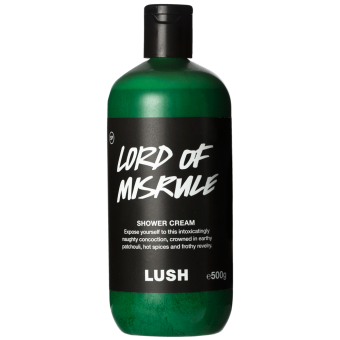
"Lord of Misrule" Shower Gel.
Illustration: LUSH
The following Text is from Wikipedia - the free encyclopaedia,
While mostly known as a British holiday custom, some folk-lorists, such as James Frazer and Mikhail Bakhtin (who is said to have plagiarised the novel idea from Frazer), have claimed that the appointment of a "Lord of Misrule" comes from a similar custom practiced during the Roman celebration of Saturnalia.
With the rise of The Puritan Party in the 17th-Century Church of England, the custom of "The Lord of Misrule" was outlawed, as it was deemed "disruptive"; even after The Restoration, the custom remained banned and soon became forgotten.
"The Lord of Misrule", in "Twelfth Night", by William Shakespeare.
Many aspects of this Play are associated with the concept of "The Lord of Misrule". The Title refers to the closing night of The Christmas Season, when the Celebration would be at its most riotous. The dislocation of the setting, a far-off land called Illyria, gives the Play a tone of a "topsy-turvy world"; the kind that "The Lord of Misrule" sends everyone to, on celebrations like the one the Play is named after. Illyria is the perfect place for "Misrule" to take over: Women become men; Servants trick Nobles; and logic becomes madness, et cetera.
unless stated otherwise.
In England, "The Lord of Misrule" – known in Scotland as "The Abbot of Unreason", and, in France , as "The Prince des Sots" – was an officer appointed by lot, during Christmastide, to preside over The Feast of Fools.
In England, "The Lord of Misrule" – known in Scotland as "The Abbot of Unreason", and, in France , as "The Prince des Sots" – was an officer appointed by lot, during Christmastide, to preside over The Feast of Fools.
"The Lord of Misrule" was generally a peasant or Sub-Deacon appointed to be in charge of Christmas revelries, which often included drunkenness and wild partying.
The Church held a similar Festival involving a Boy Bishop. This custom was abolished by King Henry VIII in 1541, restored by the Catholic Queen Mary I and again abolished by Protestant Elizabeth I, though here and there it lingered on for some time longer.
The Church held a similar Festival involving a Boy Bishop. This custom was abolished by King Henry VIII in 1541, restored by the Catholic Queen Mary I and again abolished by Protestant Elizabeth I, though here and there it lingered on for some time longer.
On The Continent, it was suppressed by The Council of Basle in 1431, but was revived in some places, from time to time, even as late as the 18th-Century. In The Tudor Period, "The Lord of Misrule" (sometimes called "The Abbot of Misrule", or, "The King of Misrule") is mentioned a number of times by contemporary documents referring to revels both at Court and among the ordinary people.
In "The Spirit of Misrule", identified by the grinning masks in the corners.
Mediaeval floor tiles,
from the Derby Black Friary,
show a triumphant Hunting Hare mounted on a Dog.
Date: Circa 13th-Century.
(Wikimedia Commons)
While mostly known as a British holiday custom, some folk-lorists, such as James Frazer and Mikhail Bakhtin (who is said to have plagiarised the novel idea from Frazer), have claimed that the appointment of a "Lord of Misrule" comes from a similar custom practiced during the Roman celebration of Saturnalia.
In ancient Rome, from the 17th to the 23rd of December (in The Julian Calendar), a man, chosen to be a mock king, was appointed for the feast of Saturnalia, in the guise of the Roman deity Saturn; at the end of the festival, the man was sacrificed.
This hypothesis has been heavily criticised by William Warde Fowler and, as such, the Christmas custom of "The Lord of Misrule" during the Christian era and the Saturnalian custom of antiquity, may have completely separate origins; the two separate customs, however, can be compared and contrasted.
With the rise of The Puritan Party in the 17th-Century Church of England, the custom of "The Lord of Misrule" was outlawed, as it was deemed "disruptive"; even after The Restoration, the custom remained banned and soon became forgotten.
In the Early-19th-Century, The Oxford Movement in The Anglican Church ushered in "the development of richer and more symbolic forms of Worship, the building of Neo-Gothic Churches, and the revival and increasing centrality of the keeping of Christmas itself as a Christian Festival", as well as "special Charities for The Poor", in addition to "special Services and musical events".
Charles Dickens, and other writers, helped in this revival of the Holiday, by "changing consciousness of Christmas and the way in which it was celebrated", as they emphasised Family, Religion, Gift-Giving, and Social Reconciliation, as opposed to the historic revelry common in some places.
The following Text is from PYRRHIC VICTORIES
Many aspects of this Play are associated with the concept of "The Lord of Misrule". The Title refers to the closing night of The Christmas Season, when the Celebration would be at its most riotous. The dislocation of the setting, a far-off land called Illyria, gives the Play a tone of a "topsy-turvy world"; the kind that "The Lord of Misrule" sends everyone to, on celebrations like the one the Play is named after. Illyria is the perfect place for "Misrule" to take over: Women become men; Servants trick Nobles; and logic becomes madness, et cetera.




No comments:
Post a Comment